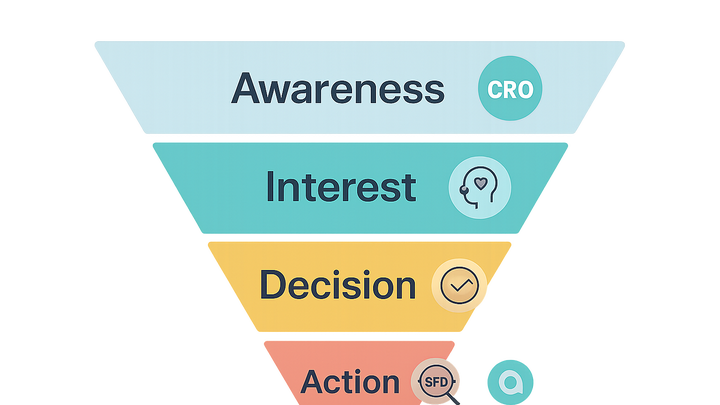Published on 2025-06-29T19:26:33Z
What is a Conversion Funnel? Examples for CRO, UX & SEO
Conversion Funnel (also known as the purchase or marketing funnel) maps the steps a website visitor takes from initial awareness to completing a target action, such as a purchase or lead submission.
It consists of four primary stages:
- Awareness: Attracting potential customers through SEO, ads, or content.
- Interest: Engaging visitors with relevant information and value propositions.
- Decision: Persuading prospects to choose your offering via social proof, demos, or trials.
- Action: Finalizing the conversion with optimized forms, checkouts, or signup flows.
By breaking down the user journey, businesses can identify where prospects drop off and apply Conversion Rate Optimization (CRO) and UX enhancements. Integrating SEO ensures each stage attracts the right audience. Tools like Prevue.me provide actionable critiques and recommendations—ranging from lead generation and UX improvements to accessibility auditing—to refine every stage of your funnel.
Conversion funnel
The Conversion Funnel maps stages visitors pass through before converting, vital for optimizing CRO, UX, and SEO on your website.
Conversion Funnel Stages
The conversion funnel breaks down the user journey into sequential stages, each representing a point where prospects may drop off. Understanding these stages helps teams optimize flow and prioritize improvements.
-
Awareness
At this top stage, prospects first discover your brand through SEO, social media, paid ads, or referrals.
- Primary objective:
Capture attention and drive high-quality traffic.
- Key metrics:
Impressions, sessions, click-through rates.
- Primary objective:
-
Interest
Visitors engage with your content or product info, seeking more details and evaluating relevance.
- Primary objective:
Maintain engagement and provide value.
- Key metrics:
Time on page, scroll depth, content interactions.
- Primary objective:
-
Decision
Prospects compare options, consult reviews, and weigh the benefits of your offering.
- Primary objective:
Build trust and reduce friction.
- Key metrics:
Demo requests, add-to-cart rate, form starts.
- Primary objective:
-
Action
The final stage where visitors complete the desired conversion like purchase, signup, or download.
- Primary objective:
Facilitate seamless conversion.
- Key metrics:
Conversion rate, bounce rate on confirmation page.
- Primary objective:
Importance for CRO, UX & SEO
A well-defined funnel aligns optimization strategies across disciplines. Each stage offers unique opportunities for improving conversion, user satisfaction, and search visibility.
-
Cro focus
Conversion Rate Optimization targets reducing drop-offs within funnel stages.
- Identifying drop-offs:
Use analytics to pinpoint where users abandon the funnel.
- Prioritizing tests:
Run A/B tests on high-impact pages like landing pages and checkout flows.
- Identifying drop-offs:
-
Ux enhancement
User Experience design ensures each funnel stage is intuitive and engaging.
- Simplify navigation:
Reduce clicks and streamline pathways to key actions.
- Responsive design:
Optimize for devices to lower friction and load times.
- Simplify navigation:
-
Seo alignment
Search Engine Optimization drives the right audience into the top of your funnel.
- Keyword-driven content:
Match content to user intent at each stage to attract qualified traffic.
- Site architecture:
Structure pages so search engines and users can follow your funnel easily.
- Keyword-driven content:
Implementing Funnel Analysis with Prevue.me
prevue.me offers an all-in-one audit platform to critique and optimize every funnel stage for maximum lead generation, accessibility, UX, and SEO performance.
-
Holistic site audits
Receive actionable feedback on UX, accessibility, and SEO to improve top-of-funnel performance.
- Actionable ux feedback:
Insights on navigation, visual hierarchy, and micro-interactions.
- Seo recommendations:
Keyword usage, metadata optimization, and content structure tips.
- Actionable ux feedback:
-
Lead generation critiques
Analyze forms, CTAs, and landing pages to boost conversion rates in the interest and decision stages.
- Cta optimization:
Best practices for copy, placement, and design.
- Form efficiency:
Strategies to reduce friction and improve completion rates.
- Cta optimization:
-
Accessibility insights
Ensure your funnel is inclusive and compliant, removing barriers for all users.
- Wcag compliance:
Check color contrast, keyboard navigation, and screen reader support.
- Assistive tech support:
Make sure interactive elements are accessible via common assistive technologies.
- Wcag compliance:
Best Practices to Optimize Your Conversion Funnel
Continuous refinement is key to improving funnel performance. Follow these principles to maintain a healthy funnel.
-
Map the user journey
Document touchpoints and user motivations to identify areas for improvement.
-
Use a/b testing continuously
Test variations of headlines, layouts, and calls to action to find what resonates best.
-
Monitor key funnel metrics
Track stage-specific conversion rates to detect trends and anomalies quickly.
-
Iterate based on data
Apply insights from analytics and user feedback to refine content, design, and flow.
